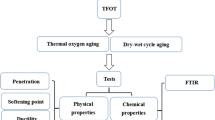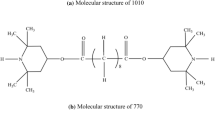Abstract
In this study, four types of SBS copolymers with different residual SB di-block content were selected and incorporated into base asphalt to prepare SBSMA. Aging samples of each group were prepared by Rolling Thin Film Oven Test (RTFOT) and Pressure Aging Vessel (PAV). The Gel permeation chromatography (GPC) and Fourier transform infrared spectroscopy (FTIR) were utilized to determine the molecular weight and analyze the chemical structure evolution of the SBS polymers and SBSMA, respectively. Besides, thermal stability and rheological properties of all asphalt binders pre and post aging were studied by Thermo gravimetric (TG) and Dynamic shear rheological (DSR), respectively. In GPC test, the Mn and Mw of SBS and the Mw of SBSMA showed a decreased trend after aging; whereas the trend of Mn of SBSMA was opposite to that of Mw. The reduction extent of molecular weight (∆T,Mn, ∆P,Mn, ∆T,Mw and ∆P,Mw) of SBS and SBSMA grew with the increase of residual SB content. As to FTIR tests of SBS and SBSMA, the CI, ∆T,IC=C and ∆P,IC=C exhibited an upward trend with the increasing residual SB content. These findings implied that the –C=C– bond in SBS broken and generated C=O bond during aging. In TG test, the T0 and TDTG max values of SBSMA decreased with the increase of residual SB content, which indicated that high residual SB in SBS reduced the thermal stability of SBSMA. The data in DSR illustrated that modified asphalt with lower residual SB content had higher (G*/sinδ) and (G*), indicating that low residual SB content had positive effect on the high temperature performance of asphalt. The result of MSCR showed the same conclusion. In addition, it was found that there was a strong correlation between the 1/(G*/sinδ), Jnr-3.2 kPa and 1/R3.2 kPa and the butadiene index reduction rate (ΔT,IC=C and ΔP,IC=C) under different aging conditions.








Similar content being viewed by others
References
Wu SP, Pang L, Mo LT et al (2009) Influence of aging on the evolution of structure, morphology and rheology of base and SBS modified bitumen. Constr Build Mater 23:1005–1010
Derya K, Ali T, Tony MN (2019) Relationship between processing parameters and aging with the rheological behaviour of SBS modified bitumen. Constr Build Mater 221:345–350
Liang M, Liang P, Fan WY et al (2015) Thermo-rheological behavior and compatibility of modified asphalt with various styrene–butadiene structures in SBS copolymers. Mater Res 88:177–185
Halit Ö (2011) Rutting evaluation of hydrated lime and SBS modified asphalt mixtures for laboratory and field compacted samples. Constr Build Mater 25:756–765
Sengoz B, Isikyakar G (2008) Analysis of styrene-butadiene-styrene polymer modified bitumen using fluorescent microscopy and conventional test methods. J Hazard Mater 150:424–432
Sengoz B, Topal A, Isikyakar G (2009) Morphology and image analysis of polymer modified bitumens. Construct Build Mater 23(5):1986–1992
Chen JS, Huang CC (2007) Fundamental characterization of SBS-modified asphalt mixed with sulfur. J Appl Polym Sci 103:2817–2825
Wang YY, Sun L, Qin YX (2015) Aging mechanism of SBS modified asphalt based on chemical reaction kinetics. Constr Build Mater 91:47–56
Cortizoa MS, Larsenb DO, Bianchettob H et al (2004) Effect of the thermal degradation of SBS copolymers during the ageing of modified asphalts. Polym Degrad Stab 86:275–282
Lu X, Isacsson U (1997) Rheological characterization of styrene-butadiene-styrene copolymer modified bitumens. Constr Build Mater 11:23–32
Sun L, Wang YY, Zhang YM (2014) Aging mechanism and effective recycling ratio of SBS modified asphalt. Constr Build Mater 70:26–35
Li ZZ, Fa CG, Zhao HY et al (2020) Investigation on evolution of bitumen composition and micro-structure during aging. Constr Build Mater 244:118322
Gao Y, Gu F, Zhao YL (2013) Thermal oxidative aging characterization of SBS modified asphalt. J Wuhan Univ Tech Mater Sci Ed 28:88–91
Xu JB, Zhang AM, Zhou T et al (2007) A study on thermal oxidation mechanism of styrene-butadiene-styrene block copolymer (SBS). Polym Degrad Stab 92:1682–1691
Li XL, Wang R, Zhang RQ et al (2019) Mechanism of thermal oxidative aging of butadiene rubber. Polym Mater Sci Eng 35:107–111
Cheng HJ, Zhu XY, Song YP et al (2017) Analysis on quality influencing factors and process control in production of SBS. China Elastomericws 27:53–58
Abbas Ala R, Mannan Umme A, Dessouky S (2013) Effect of recycled asphalt shingles on physical and chemical properties of virgin asphalt binders. Constr Build Mater 45:162–172
Hao GR, Huang WD, Yuan J et al (2017) Effect of aging on chemical and rheological properties of SBS modified asphalt with different compositions. Constr Build Mater 156:902–910
Chen JH, Li CR (1985) Thermal analysis and application, 3rd edn. Science Press, Beijing
Juan M, Jiménez M, Luis CQ et al (1996) Characterization of petroleum bitumens and their fractions by thermogravimetric analysis and differential scanning calorimetry. Fuel 75:1691–1700
Radhakrishnan CK, Sujith A, Unnikrishnan G (2007) Thermal behaviour of styrene butadiene rubber/poly(ethylene-co-vinyl acetate) blends TG and DSC analysis. J Therm Anal Calorim 90:191–199
Zhang F, Hu CB (2014) Influence of aging on thermal behavior and characterization of SBR compound-modified asphalt. J Therm Anal Calorim 115:1211–1218
Zhang F, Yu JY, Han J (2011) Effects of thermal oxidative ageing on dynamic viscosity, TG/DTG, DTA and FTIR of SBS- and SBS/sulfur-modified asphalts. Constr Build Mater 25:129–137
Tian Y, Li H, Zhang HJ et al (2021) Comparative investigation on three laboratory testing methods for short-term aging of asphalt binder. Constr Build Mater 266:121204
Yan CQ, Huang WD, Ma JM, Xu J et al (2020) Characterizing the SBS polymer degradation within high content polymer modified asphalt using ATR-FTIR. Constr Build Mater 233:117708
Shan L, Qi X, Duan X, Liu S, et al (2020) Effect of styrene-butadiene-styrene (SBS) on the rheological behavior of asphalt binders. Constr Build Mater 231:117076.
Yan C, Huang W, Lin P et al (2019) Chemical and rheological evaluation of aging properties of high content SBS polymer modified bitumen. Fuel 252:417–426
Sun GQ, Li B, Sun DQ et al (2021) Chemo-rheological and morphology evolution of polymer modified bitumens under thermal oxidative and all-weather aging. Fuel 285:118989
Du PF, Chen ZH et al (2018) Rheological and aging behaviors of base and SBS modified asphalt with thermochromic microcapsule. Constr Build Mater 200:1–9
Zhang DM, Zhang HL et al (2017) Synergetic effect of multidimensional nanomaterials for anti-aging properties of SBS modified bitumen. Constr Build Mater 144:423–431
Shao LL, Wang HN, Zhang R et al (2021) Analysis of the chemical properties and high-temperature rheological properties of MDI modified bio-asphalt. Constr Build Mater 267:121044
Xu J, Sun LJ, Pei JZ et al (2021) Microstructural, chemical and rheological evaluation on oxidative aging effect of SBS polymer modified asphalt. Constr Build Mater 267:121028
Acknowledgements
The authors gratefully acknowledge the financial support from the Natural Science Foundation of Xinjiang Uygur Autonomous Region (No. 2019D01A44), the National Natural Science Foundation of China (No. 51808051), the Basic Research Project of Natural Science in Shaanxi Province (No. 2019JQ-118), the Special Project of Technical Innovation Guidance in Shaanxi Province (No. 2019QYPY-145).
Author information
Authors and Affiliations
Corresponding author
Ethics declarations
Conflict of interest
There are no conflicts of interest.
Additional information
Publisher's Note
Springer Nature remains neutral with regard to jurisdictional claims in published maps and institutional affiliations.
Rights and permissions
About this article
Cite this article
Li, Z., Liu, H., Chen, W. et al. Influence of residual SB di-block in SBS on the thermo–oxidative aging behaviors of SBS and SBS modified asphalt. Mater Struct 55, 23 (2022). https://doi.org/10.1617/s11527-022-01882-3
Received:
Accepted:
Published:
DOI: https://doi.org/10.1617/s11527-022-01882-3




